Pump Handbook by Igor J. Karassik, Joseph P. Messina, Paul Cooper, Charles C. Heald - 3rd edition
Подождите немного. Документ загружается.

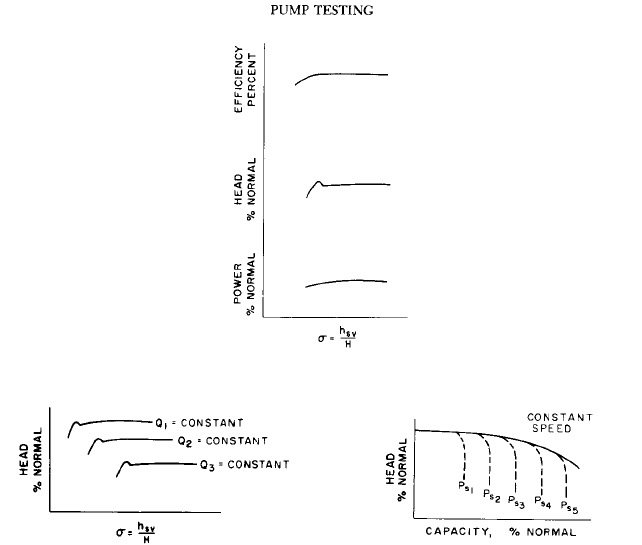
13 PUMP TESTING 13.11
FIGURE 6 Functions of sigma at constant capacity and speed; suction pressure varied
FIGURE 7 Sigma capacities above and below
normal; suction pressure varied
FIGURE 8 Typical cavitation curves at constant
speed and suction pressure
can be varied by a gas pressure over the liquid, by temperature of the liquid, or by a com-
bination of these.
By using one of these cavitation test arrangements, the critical value of s (that is, the
value at which cavitation will begin) can be found by one of the following two methods:
1. Constant speed and capacity vary the suction lift. Run the pump at constant speed
and capacity with the suction lift varied to produce cavitation conditions. Plots of the
head, efficiency, and power input against s as shown in Figure 6.
When the values of s are held high, the values of head, efficiency, and power should
remain relatively constant. As s is reduced, a point is reached when the curves break
from the normal, indicating an unstable condition. This breakaway condition may and
usually does impair the operation of the pump. The extent of impairment depends on
the size, specific speed, and service of the pump and on the characteristics of the
pumped fluid. A variation of this method is to plot results using capacities both
greater and less than normal, as shown in Figure 7.
2. Constant speed and suction lift vary the capacity. Run the pump at constant speed
and suction lift and vary the capacity. For a given suction lift, the pumping head is
plotted against capacity. A series of such tests will result in a family of curves, as
shown in Figure 8.
Where the plotted curve for any suction condition breaks away from the normal, cavi-
tation has occurred. The value of s may be calculated at the breakaway points by dividing
NPSHA by total head H at the point under consideration.
13.12 CHAPTER THIRTEEN
TEST PROCEDURE ___________________________________________________
Agreements
The specifications and contract should be very clear on any special
points that must be covered by the pump testing. All interested parties shall be repre-
sented and given equal rights in regard to test date, setup, conditions, instrumenta-
tion, calibration of instruments, examination of pump and test setup, and accuracy of
results and computations. Any controversial points or methods not provided for in the
specifications should be resolved to the satisfaction of all interested parties before test-
ing is begun.
In some special instances and by agreement between parties, an independent test
expert may be engaged to take over full responsibility of the test stand and apparatus.
This person will make all decisions after consultation with the interested parties and
should be used only where an impasse is reached.
Normally, the manufacturer will establish the time and date for the pump tests. In
some cases, the specifications will cover such items as duration, limiting date, and notifi-
cation time. Reasonable notice must be given to all official witnesses or representatives. A
30-day notice is preferred, and one week should be considered a bare minimum.
Any time limitation regarding correction of mechanical defects or equipment malfunc-
tions that arise during testing must be resolved by mutual agreement.
Observers and Witnesses Representatives from each party to the contract shall have
equal opportunity to attend the testing. Where more than one representative from one of
the parties is present, their function as observers, official witnesses, or representatives
must be made clear before the start of testing. The number of representatives present
from any one party shall not be a deciding factor when disagreements are being resolved.
Any comments or constructive criticism from the observers and witnesses should be duly
considered.
Inspection and Preliminary Operation All interested parties shall make as complete
an inspection as possible before, during, and after the test to determine compliance with
specifications and correct connection of all instrumentation. The following items should
be inspected before or during the test:
• Impeller and casing passages
• Pump and driver alignment
• Piezometer openings
• Electrical connections
• Lubricating devices and system
• Wearing ring and other clearances
• Stuffing box or mechanical seal adjustment and leakage
This is not a complete list of items and should be taken as only a guide for the inter-
ested parties. Instruments installed on the pump to obtain the necessary test information
shall not affect the pump operation or performance. If a question arises as to the effect an
instrument has on the operation, it should be resolved by all parties. Where necessary,
comparative preliminary tests can be conducted with the disputed equipment removed
and then reinstalled. The dimensions at the piezometer connections on both the suction
and discharge sides must be accurately determined to permit accurate determination of
the velocity head correction.
On satisfactory completion of the preliminary inspection, the pump may be started.
The pump and all instrumentation should then be checked for proper operation, scale
readings, or evidence of malfunction. When all equipment and apparatus are functioning
properly, a preliminary test run should be made. If possible, this run should be made at or
near the rated condition. The correct procedures for observing and recording the data
should be established during this run. Also, the time it takes to obtain steady test condi-
tions is determined for use in the pump test runs. The acceptable deviations and fluctua-
tions for test readings are given in the section named “Accuracy.”
13 PUMP TESTING 13.13
Suggested Test Procedure
TIME AND DATE
After tests have been decided upon, it is to the best interests of all parties
to conduct them with the least delay. The contract normally will not give a time or date
for the test, but will specify a completion date for submission or approval of a final test
report.
PERSONNEL Pump testing, regardless of classification, should be carried out by personnel
specially trained in the operation of the test equipment used. Representatives from each
party to the contract shall be given equal opportunity to witness the test or tests and shall
also have equal voice in commenting on the conduct of the tests or on compliance with
specifications or code requirements where applicable.
SCHEDULE
A schedule should be agreed upon by all parties in advance of the test. The
schedule should be as complete a program as possible and give some particulars on the
range of test heads, discharge rates, and speed to be used. This schedule should be flexi-
ble and subject to change, especially after the preliminary runs have been made.
INSPECTION The pump and test setup should be thoroughly inspected both before and
after the tests. Special attention should be given to the hydraulic passages and pressure
taps near the suction and discharge sections. Also, the discharge measuring device should
be inspected.
CALIBRATION OF INSTRUMENTS
While the setup is being inspected, all measuring devices
should be calibrated and adjusted as explained under the section named “Instrumentation.”
PRELIMINARY TESTS
After it has been determined that the test setup complies with the
installation and specification requirements and that the instrumentation is properly
installed, the pump is started. A sufficient number of preliminary test runs should be
made to check the functioning of the test stand and all control and measuring devices.
These preliminary tests also give the test personnel and representatives an opportunity
to check and adjust the entire setup and serve as a basis for agreements on accuracy and
compliance. Each test point is held until satisfactory stable conditions exist. The accept-
able fluctuations in test readings is covered under “Accuracy.” It is suggested that pre-
liminary computations be made, plotted, and analyzed prior to actual test runs. (Note:
Most pump manufacturers will conduct a complete preliminary shop test to be sure of
specifications and contractual compliance before inviting the purchaser’s representatives
to witness the official test.)
OFFICIAL TEST RUNS The test points for the official test runs must be sufficient in number
to establish the head-discharge curve over the specified range and to provide any other
data needed to compute or plot the information required by the specifications. It is sug-
gested that one test run be as near the rated condition as possible and that at least three
runs be in the specified operating range of the pump.
LOGGING OF EVENTS In most instances, the official pump test is conducted by only two,
three, or four test engineers, and no record other than test data is needed. In more com-
plicated or important tests, it is sometimes very desirable to assign someone the task of
recording and logging events as they occur. This is most important if reruns are required.
Complete records, including any notes or comments on inspection and calibration, shall
be kept of all data, readings, observations, and information relevant to the test. A sug-
gested form for shop and field tests is shown in Figure 28.
PRELIMINARY COMPUTATIONS Sufficient preliminary computations should be made to deter-
mine whether all specification requirements have been met and whether reruns will be
necessary.

13.14 CHAPTER THIRTEEN
TABLE 3 Liquid meters and their functions
Quantity meters Rate-of-flow meters
Weighing meters Differential pressure meters
Weighing tank Venturi
Tilting trap Nozzle
Volumetric meters Orifice plate
Tank Pitot tube
Reciprocating piston Head area meters
Rotary piston Weir
Nutating disk Flume
Current meters
RERUNS When the preliminary computations indicate that reruns are necessary, they
should be run immediately or as soon as possible after the official test runs and with the
same personnel, instruments, and devices. Sometimes mechanical or electrical faults will
necessitate a rerun. If after correction of these faults several reruns indicate a change, a
complete retesting may be required. Any official representatives shall have the right to
ask for a rerun or be shown to their satisfaction that a rerun is not required.
COMPUTATIONS, PLOTTING REPORTS
These topics are discussed later in the text.
TEST MEASUREMENTS _______________________________________________
DISCHARGE The choice of which method of discharge measurement to use should be made
by agreement between all parties concerned. Some test codes and procedures in regular
use permit or even recommend certain methods for model or shop testing, but restrict their
use in field or index testing. Some methods are more adaptable to the site conditions than
others, and so the test engineers and interested parties should be completely familiar with
the several methods applicable before settling on the one to be used.
The most commonly used methods of discharge measurement are those that use quan-
tity meters and those that use rate-of-flow meters. Both meters are usually classified as
liquid meters, and their functions are listed in Table 3.
QUANTITY METERS The term quantity is here used to designate those meters in which the
fluid passes through the primary element in successive and more or less completely iso-
lated quantities, either weights or volumes, by alternately filling and emptying contain-
ers of known capacities. The secondary element of a quantity meter consists of a counter
with suitably graduated dials for registering the total quantity that has passed through.
Quantity meters are classified into two groups: weighing meters and volumetric meters.
WEIGHING METERS There are two types of weighing meters: weighing tank and tilting trap.
In the tilting trap meter, the equilibrium of a container is upset by a rise of the center of
gravity as the container is filled.Weighing tank meters employ a container suspended from
a counterbalanced scale beam. The weighing tank and the tilting trap are affected slightly
by the temperature of the liquid but not enough to cause concern in normal testing.
VOLUMETRIC METERS Volumetric meters measure volumes instead of weights. There are
four types: tank, reciprocating piston, rotary piston, and nutating disk.
Tank meters are a very elementary form of meter of limited commercial importance.As
the name implies, they consist of one or more tanks that are alternately filled and emptied.
The height to which they are filled can be regulated manually or automatically. In some
cases, the rising liquid operates a float that controls the inflow and outflow; in others, it
13 PUMP TESTING 13.15
starts a siphon. Occasionally, some tank meters have been erroneously classified as weigh-
ing meters.
Reciprocating piston meters use one or more members that have a reciprocating
motion and operate in one or more fixed chambers. The quantity per cycle can be adjusted
either by varying the magnitude of movement of one or more of the reciprocating members
or by varying the relation between the primary and secondary elements.
Rotary (or oscillating) piston meters have one or more vanes that serve as pistons or
movable partitions for separating the fluid segments. These vanes may be either flat or
cylindrical and rotate within a cylindrical metering chamber. The axis of rotation of the
vanes may or may not coincide with that of the chamber. The portion of the chamber in
which the fluid is measured usually includes about 270°. In the remaining 90°, the vanes
are returned to the starting position for closing off another segment of fluid. This may be
accomplished by the use of an idle rotor or gear, a cam, or a radial partition. The vanes
must make almost a wiping contact with the walls of the measuring chamber. The rotation
of the vanes operates the counter.
Nutating disk meters have the disk mounted in a circular chamber with a conical roof
and either a flat or conical floor. When in operation, the motion of the disk is such that the
shaft on which it is mounted generates a cone with the apex down. However, the disk does
not rotate about its own axis; this is prevented by a radial slot that fits about a radial par-
tition extending in from the chamber sidewall nearly to the center. The peculiar motion of
the disk is called nutating. The inlet and outlet openings are in the sidewall of the cham-
ber on either side of the partition. These meters are usually adjusted by changing the rela-
tion between the primary and secondary elements.
RATE-OF-FLOW METERS
The term rate of flow is applied to all meters through which the fluid
passes not in isolated quantities but in a continuous stream. The movement of this fluid
stream through the primary element is directly or indirectly utilized to actuate the sec-
ondary element. The quantity of flow per unit time is derived from the interactions of the
stream and the primary element, using physical laws supplemented by empirical relations.
In rate-of-flow meters, the functioning of the primary element depends upon some
property of the fluid other than, or in addition to, volume or mass. This property may be
kinetic energy (head meters), inertia (gate meters), specific heat (thermal meters), or the
like. The secondary element senses a change in the property concerned and usually
embodies some device that draws the necessary inferences automatically, so the observer
can read the rate of flow from a dial or chart. In some cases, the secondary element records
pressures, such as static and differential, from which the rate of flow and time-quantity
flow must be computed. In others, the secondary element not only indicates the rate of flow
but also integrates it with respect to time and records the total quantity that has passed
through the meter. In some cases, the indications of the secondary element are transmit-
ted to a point some distance from the primary element.
DIFFERENTIAL PRESSURE METERS With this group of meters the stream of fluid creates a pres-
sure difference as it flows through the primary element. The magnitude of this pressure dif-
ference depends upon the speed and density of the fluid and features of the primary element.
3
Flow in a pipeline, or closed pressure conduit, can be measured by a wide variety of
methods, and the choice of method for a particular installation will depend upon prevail-
ing conditions. The accuracy of flow measurements in pressure conduits made with prop-
erly selected, installed, and maintained measuring equipment, such as venturi meters,
flow nozzles, orifice meters, and pitot tubes, can be very high.
The venturi meter (Figure 9) is perhaps the most accurate flow measuring device that
can be used in a water supply system. It contains no moving parts, requires very little
maintenance, and causes very little head loss.Venturi meters operate on the principle that
flow in a closed conduit system is faster through areas of small cross section (D
2
in Figure
9) than through areas of large cross action (D
1
). The total energy in the flow, consisting pri-
marily of velocity head and pressure head, is essentially the same at D
1
and D
2
. Thus the
pressure must decrease in the constricted throat D
2
, where the velocity is higher, and con-
versely must increase at D
1
upstream from the throat, where the velocity is lower. This
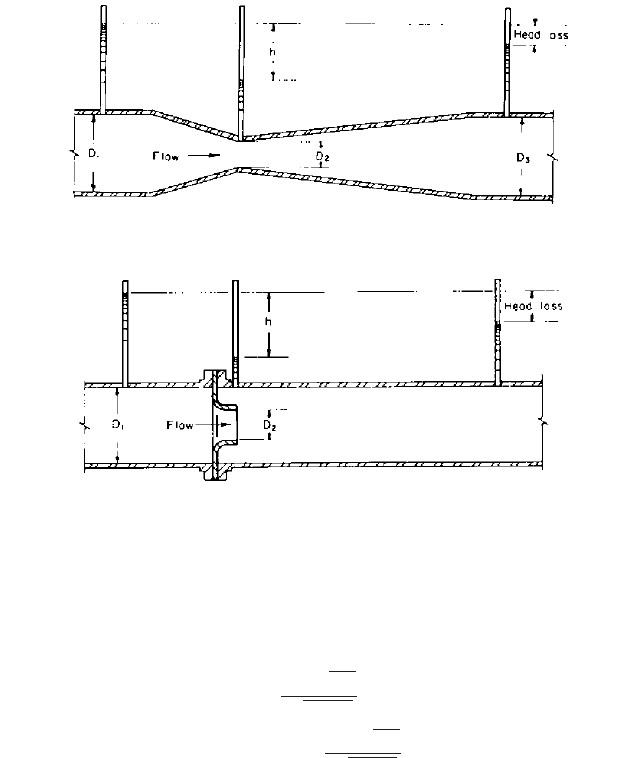
13.16 CHAPTER THIRTEEN
FIGURE 9 Diagram of venturi meter
FIGURE 10 Diagram of flow nozzle
reduction in pressure from the meter entrance to the meter throat is directly related to the
rate of flow through the meter and is the measurement used to determine flow rate.
The coefficient of discharge for the venturi meter ranges from 0.935 for small-throat
velocities and diameters to 0.988 for large-throat velocities and diameters. Equations for
the venturi meter are
where Q rate of flow, ft
3
/s (m
3
/s)
C coefficient of discharge for meter
A
2
area of throat section, ft
2
(m
2
)
g acceleration of gravity, 32.17 ft/s
2
(9.81 m/s
2
)
h differential head of liquid between meter inlet and throat, ft (m)
R ratio of throat to inlet diameter (D
2
/D
1
)
Q¿ rate of flow, gpm
A¿
2
area of throat section, in
2
Flow nozzles operate on the same basic principle as venturi meters. In effect, the flow
nozzle is a venturi meter that has been simplified and shortened by omission of the long
diffuser on the outlet side (Figure 10). The streamlined entrance of the nozzle provides a
Q¿ 3.118
CA
2
œ
22gh
21 R
4
Q
CA
2
22gh
21 R
4
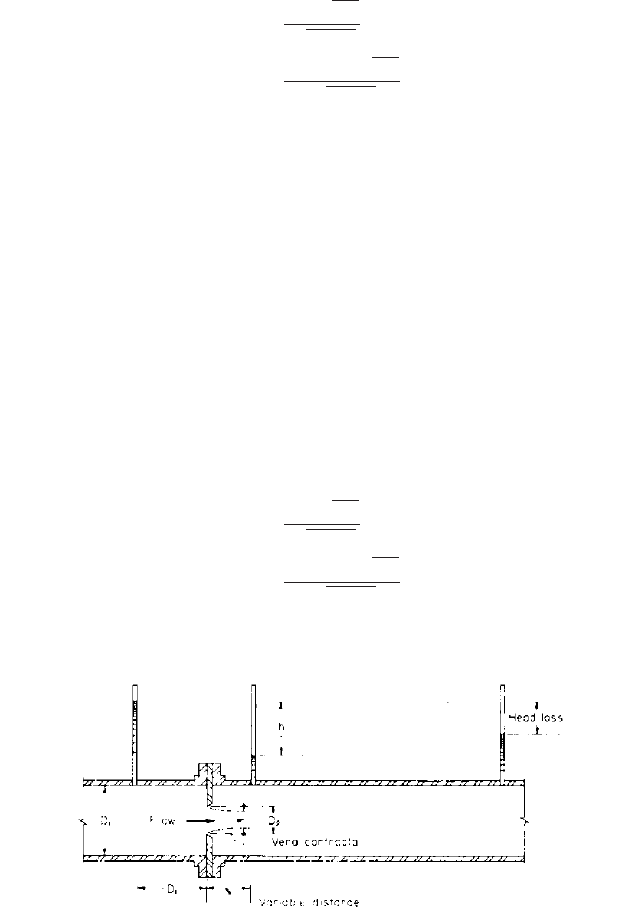
13 PUMP TESTING 13.17
FIGURE 11 Diagram of orifice meter
straight cylindrical jet without contraction, so the coefficient of discharge is almost the
same as that for the venturi meter. In the flow nozzle, the jet is allowed to expand of its
own accord, and the high degree of turbulence created downstream from the nozzle causes
a greater loss of head than occurs in the venturi meter, where the diffuser suppresses tur-
bulence. The relationship of flow rate to head and flow nozzle dimensions is
where Q rate of flow, ft
3
/s (m
3
/s)
C coefficient of discharge for nozzle
A
2
area of nozzle throat, ft
2
(m
2
)
g acceleration of gravity, 32.17 ft/s
2
(9.81 m/s
2
)
h head at or across the nozzle, ft (m)
R ratio of throat to inlet diameter (D
2
/D
1
)
Q¿ rate of flow, gpm
A
2
¿ area of nozzle throat, in
2
In an orifice meter, a thin plate orifice inserted across a pipeline is used for measuring
flow in much the same manner as a flow nozzle (Figure 11). The upstream pressure con-
nection is often located about one pipe diameter upstream from the orifice plate. The pres-
sure of the jet ranges from a minimum at the vena contracta (the smallest cross section of
the jet) to a maximum at about four or five conduit diameters downstream from the orifice
plate.The downstream pressure connection (the center connection in Figure 11) is usually
made at the vena contracta to obtain a large pressure differential across the orifice.
The pressure tap openings should be free from burrs and flush with the interior sur-
faces of the pipe. Equations for the orifice plate are
Q¿
3.118CA
2
œ
22gh
21 R
4
Q
CA
2
22gh
21 R
4
Q¿
3.118CA
2
œ
22gh
21 R
4
Q
CA
2
22gh
21 R
4

13.18 CHAPTER THIRTEEN
where Q rate of flow, ft
3
/s (m
3
/s)
C coefficient of discharge for orifice plate
A
2
area of orifice, ft
2
(m
2
)
g acceleration of gravity, 32.17 ft/s
2
(9.81 m/s
2
)
h head across the orifice plate, ft (m)
R ratio of throat to inlet diameter (D
2
/D
1
)
Q¿ rate of flow, gpm
A¿
2
area of orifice, in
2
The principal disadvantage of orifice meters, compared with venturi meters and flow
nozzles, is their greater loss of head. On the other hand, they are inexpensive and capable
of producing accurate flow measurements.
It should be noted that the relationship of flow rate to head and dimensions of the
metering section is identical for the venturi meter, flow nozzle, and orifice meter except
that the coefficients of discharge vary.
Where it is impossible to employ one of the methods previously described, the pitot
tube is often used. A pitot tube in its simplest form consists of a tube with a right-angle
bend which, when partly immersed with the bent part under water and pointed directly
into the flow, indicates flow velocity by the distance water rises in the vertical stem.The
pitot tube makes use of the difference between the static and total pressures at a sin-
gle point.
The height of rise h of the water column above the water surface, expressed in feet
(meters) and tenths of feet (millimeters), equals the velocity head v
2
/2g. The velocity of
flow v in feet (meters) per second may thus be determined from the relation
In a more complete form known as the pitot static tube, the instrument consists of two
separate, essentially parallel parts, one for indicating the sum of the pressure and veloc-
ity heads (total head) and the other for indicating only the pressure head. Manometers are
commonly used to measure these heads, and the velocity head is obtained by subtracting
the static head from the total head. A pressure transducer may be used instead of the
manometer to measure the differential head. Oscillographic or digital recording of the
electric signal from the transducer provides a continuous record of the changes in head.
The simple form of the pitot tube has little practical value for measuring discharges in
open channels handling low-velocity flows because the distance the water in the manome-
ter tube rises is difficult to measure.This limitation is overcome to a large extent by using
a pressure transducer for the measurement and precise electronic equipment for the data
readings.
The pitot static tube, on the other hand, works very well for this purpose if the tube is
used with a differential manometer of the suction lift type (Figure 12). In this manometer,
the two legs are joined at the top by a T that connects to a third line, in which a partial vac-
uum can be created. After the pitot tube has been bled to remove all air, water flows up
through it into the manometer to the height desired for easy reading. Then the stopcock
or clamp on the vacuum line is closed.The partial vacuum acts equally on the two legs and
does not change the differential head. The velocity head h is then the difference between
the total head reading and the static head reading. If desired, a pressure transducer can
also be used for the head measurement.
Pitot tubes can be used to measure relatively high velocities in canals, and it is often
possible to make satisfactory discharge measurements at drops, chutes, overfall crests, or
other stations where the water flows rapidly and fairly large velocity heads occur. At low
velocities, values of h become quite small. The pitot tube head error for a low velocity will
lead to a much larger inaccuracy in discharge computation than the same error when the
velocity is high. The velocity traverse with a pitot tube may be made in the same manner
as with a current meter (discussed later).
HEAD AREA METERS The instruments used to measure flow in open conduits are normally
classified as head area meters, the most common of which are weirs and flumes.
v 12gh.
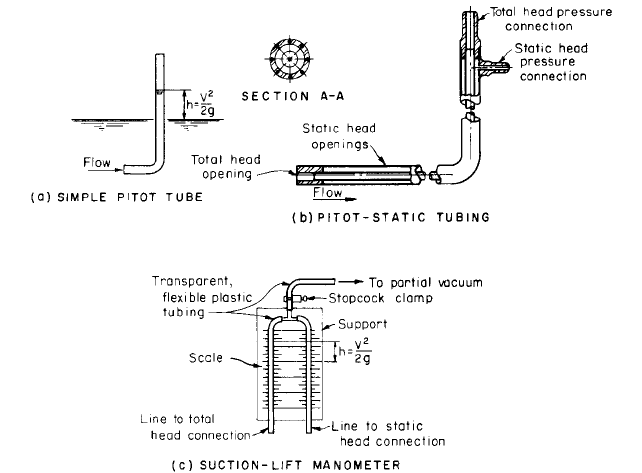
13 PUMP TESTING 13.19
FIGURE 12A through C Pilot tubes and manometer.
A weir is an overflow structure built across an open channel. Weirs are one of the old-
est, simplest, and most reliable structures for measuring the flow of water in canals and
ditches. These structures can be easily inspected, and any improper operations can be
quickly detected and corrected.
The discharge rates are determined by measuring the vertical distance from the crest
of the overflow portion of the weir to the water surface in the pool upstream from the crest
and referring to computation tables that apply to the size and shape of the weir. For stan-
dard tables to apply, the weir must have a regular shape and definite dimensions and
must be placed in a bulkhead and pool of adequate size so the system performs in a stan-
dard manner.
Weirs may be termed rectangular, trapezoidal, or triangular, depending upon the shape
of the opening. In rectangular and trapezoidal weirs, the bottom edge of the opening is the
crest and the side edges are called sides or weir ends (Figures 13 and 14). The sheet of
water leaving the weir crest is called the nappe. In certain submerged conditions, the
under-nappe airspace must be ventilated to maintain near-atmospheric pressure.
The types of weirs most commonly used to measure water are
• Sharp-crested and sharp-sided Cipolletti weirs
• Sharp-sided 90° V-notch weirs
• Sharp-crested contracted rectangular weirs
• Sharp-crested suppressed rectangular weirs
For measuring water flow, the type of weir used has characteristics that make it suit-
able for a particular operating condition. In general, for best accuracy, a rectangular sup-
pressed weir or a 90° V-notch weir should be used.
The discharge in second-feet (cubic meters per second) over the crest of a contracted
rectangular weir, a suppressed rectangular weir, or a Cipolletti weir is determined by the
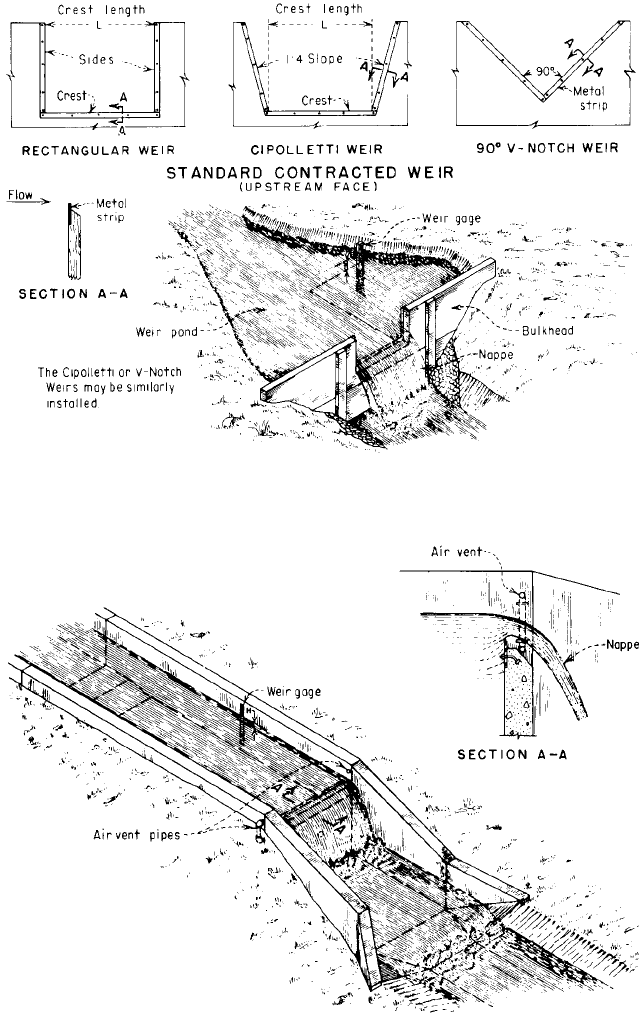
13.20 CHAPTER THIRTEEN
FIGURE 13 Standard contracted weirs and temporary bulkhead with contracted rectangular weir discharging at
free flow
FIGURE 14 Typical suppressed weir in a flume drop
